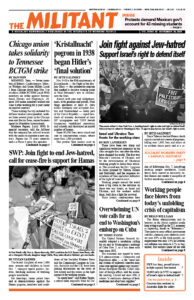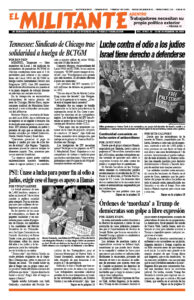There have been two sharp and significant watershed moments in the class struggle that, one after the other, have changed the world. The first was Moscow’s invasion of Ukraine, met by the determination of Ukrainian working people to defeat their attacker. The second was the Oct. 7 pogrom in Israel planned by Tehran, Hamas and Hezbollah, and the response everywhere of Jews and other defenders of the right of Israel to exist.
Working people around the world have a big stake in the outcome on these two war fronts, as Israel and Ukraine, and the workers within them, both face a fight for survival.
These historic confrontations have accelerated tensions and conflicts between working people on the one side and reactionary forces on both the left and right of bourgeois politics on the other. Most importantly, they pose the need for a decisive working-class road forward.
In its attempt to crush the country and people of Ukraine, Moscow has deepened its alignment with Tehran. Many of the Russian drones striking Ukrainian cities in its genocidal bombardment are supplied by Iran’s reactionary rulers. The capitalist clerical regime there proclaims it will wipe Jews in Israel from the face of the earth and is accelerating its development of nuclear weapons. And nuclear-armed Moscow has increased its technical help to Tehran.
The Kremlin’s hosting of top Hamas officials after Oct. 7 laid the tinder for an attempted pogrom three weeks later against Jews in the majority-Muslim Russian republic of Dagestan. The Kremlin had the nerve to try to frame Kyiv and Washington for this explosion of Jew-hatred.
The Vladimir Putin government’s reactionary policies spur the wave of antisemitic threats and violence today. Its repressive response to protests against its war in Ukraine is especially brutal against oppressed nationalities and oppressed regions such as Dagestan.
The Putin regime’s course has sharpened tensions with the Israeli government, which until now has been reluctant to support Kyiv or criticize the Kremlin. Israel’s rulers have relied on cooperation from Moscow to allow its airstrikes on Tehran’s militias and arms shipments across Syria.
“Ukraine and Israel are fighting the same existential war,” Olga Frayman, a Jewish member of Minnesota’s Ukrainian community, told the Minneapolis Star Tribune at a Nov. 2 press conference expressing solidarity with the two struggles. Her parents had moved with her from Ukraine, then an oppressed part of the Soviet Union, after the 1986 nuclear meltdown at Chernobyl.
“Ukraine and Israel are connected because Hamas and Russia are connected,” she said. But “the celebrations of the [Hamas] atrocities right here in the U.S., the antisemitic genocidal chants” by campus protesters, she said, mean “they just don’t get it. But you know who gets it? The Ukrainians do.”
A particular target of Moscow’s nightly bombardments of civilians in urban areas is Kherson, hit with 87 guided aerial bombs Nov. 5. Residential buildings were heavily damaged.
The city was captured by Russian forces early in the war. Months of spirited resistance by residents, much of it captured on video, demoralized Russian forces and weakened their occupation. Kherson was liberated by Ukrainian troops a year ago, but it’s still in range of Moscow’s artillery, missiles and drones.
The unending shelling and bombing has caused a stream of civilian casualties among the less than 20% of Kherson’s population still remaining in the city. Moscow’s war on the Ukrainian people hasn’t forced their submission, so Putin is punishing the population for their resistance. Ukrainian forces have now established a beachhead across the Dnipro River near Kherson, a new foothold on the Russian-held east bank.
Heavy Russian losses
In Avdiivka, in eastern Ukraine, a fierce battle is raging over the bombed-out town just a few miles from the Russian-occupied city of Donetsk.
The Kremlin’s high command is sending “meat waves” of poorly armed and trained soldiers against fortified Ukrainian positions. These forces have suffered 5,000 casualties and lost 400 armored vehicles since Oct. 10. There have been mutinies in some units. To try and stem flight, some Russian commanders have ordered retreating soldiers to be shot.
From the north Russian city of Kirov, a recent video appeal to Putin from wives and mothers of soldiers thrown into combat in the Donbas region protests their treatment. “Local commanders used violence and the threat of violence to force the Kirov reservists to conduct bloody attacks across open ground,” they say, leaving many killed or wounded.
The Kremlin is trying to keep a lid on growing sentiment among working people against the carnage. Repressive measures have been steadily tightened by imprisoning hundreds of political prisoners.
People across the country opposed to the Kremlin’s war in Ukraine and the political repression at home held demonstrations and laid flowers Oct. 30, calling it Political Prisoner Day.

